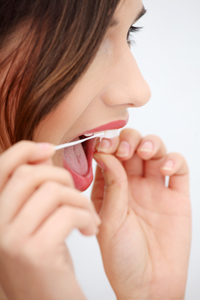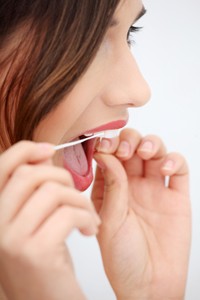
10 Feb Facts on Flossing
 Flosses and picks
Flosses and picks
Plaque is a sticky layer of material containing germs that accumulates on teeth, including places where toothbrushes can’t reach. This can lead to gum disease. The best way to get rid of plaque is to brush and floss your teeth carefully every day. The toothbrush cleans the tops and sides of your teeth. Dental floss cleans in between them. Some people use waterpiks, but floss is the best choice.
Should I floss?
Yes. Floss removes plaque and debris that adhere to teeth and gums in between teeth, polishes tooth surfaces, and controls bad breath. Floss is the single most important weapon against plaque, perhaps more important than the toothbrush. Many people just don’t spend enough time flossing or brushing and many have never been taught to floss or brush properly. When you visit your dentist or hygienist, ask to be shown.
Which type of floss should I use?
Dental floss comes in many forms: waxed and unwaxed, flavored and unflavored, wide and regular. Wide floss, or dental tape, may be helpful for people with a lot of bridgework. Tapes are usually recommended when the spaces between teeth are wide.
They all clean and remove plaque about the same. Waxed floss might be easier to slide between tight teeth or tight restorations. However, the unwaxed floss often makes a squeaking sound to let you know your teeth are clean. Bonded unwaxed floss does not fray as easily as regular unwaxed floss, but does tear more than waxed floss.
How should I floss?
There are two flossing methods: the spool method and the loop method. The spool method is suited for those with manual dexterity. Take an 18-inch piece of floss and wind the bulk of the floss lightly around the middle finger. (Don’t cut off your finger’s circulation!) Wind the rest of the floss similarly around the same finger of the opposite hand. This finger takes up the floss as it becomes soiled or frayed. Maneuver the floss between teeth with your index fingers and thumbs. Don’t pull it down hard against your gums or you will hurt them. Don’t rub it side to side as if you’re shining shoes. Bring the floss up and down several times forming a “C” shape around the tooth being sure to go below the gum line.
The loop method is suited for children or adults with less nimble hands, poor muscular coordination or arthritis. Take an 18-inch piece of floss and make it into a circle. Tie it securely with three knots. Place all of the fingers, except the thumb, within the loop. Use your index fingers to guide the floss through the lower teeth, and use your thumbs to guide the floss through the upper teeth, going below the gumline forming a “C” on the side of the tooth.
How often should I floss?
At least once a day. To give your teeth a good flossing, spend at least two or three minutes.
What about floss holders?
You may prefer a prethreaded flosser or floss holder, which often looks like a little hacksaw. Flossers are handy for people with limited dexterity, for those who are just beginning to floss, or for caretakers who are flossing someone else’s teeth.
Is it safe to use toothpicks?
In a pinch, toothpicks are effective at removing food between teeth, but for daily cleaning of plaque between teeth, floss is recommended. Toothpicks come round and flat, narrow and thick. When you use a toothpick, don’t press too hard as you can break off the end and lodge it in your gums.
Do I need a waterpick (irrigating device)?
Don’t use waterpicks as a substitute for toothbrushing and flossing. But they are effective around orthodontic braces that retain food in areas a toothbrush cannot reach. However, they do not remove plaque.
Waterpicks are frequently recommended for persons with gum disease when recommended by your dentist. Prescription solutions containing antibacterial agents like chlorhexidine or tetracycline can be added to the reservoir.


